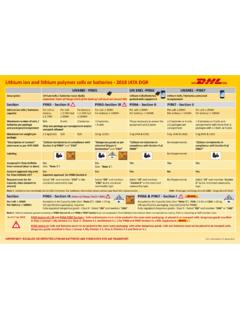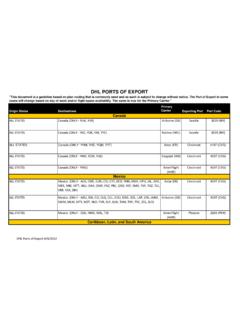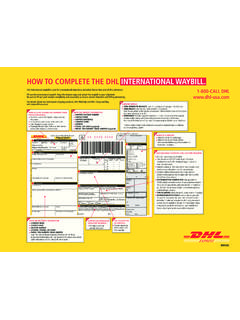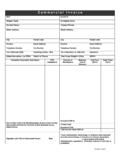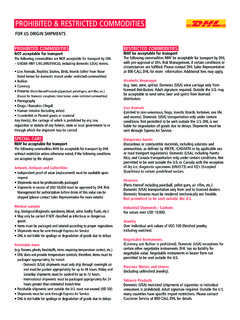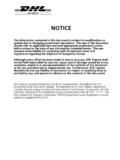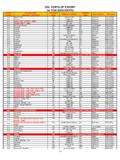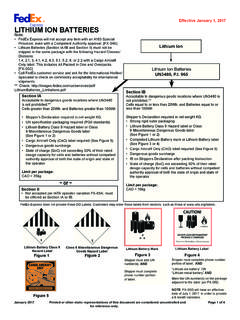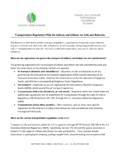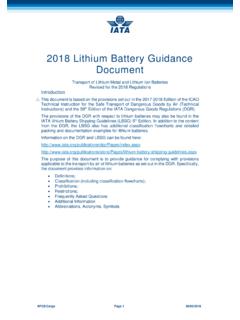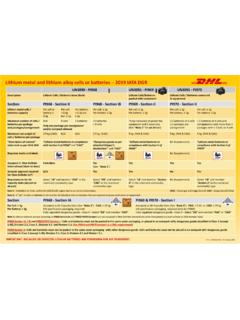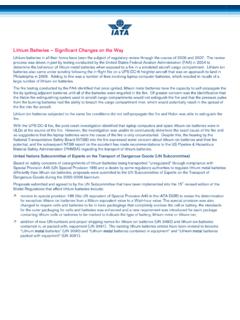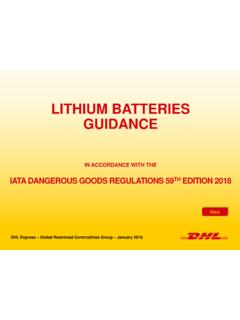Transcription of LITHIUM BATTERIES GUIDANCE - International Shipping
1 LITHIUM BATTERIES GUIDANCE IN ACCORDANCE WITH THE IATA DANGEROUS GOODS REGULATIONS 57TH EDITION 2016 DHL Express Global Restricted Commodities Group Next January 2016 2016 LITHIUM BATTERIES Regulations Defective / Damaged BATTERIES : DHL will NOT accept any shipments with LITHIUM BATTERIES (ion or metal ) that are confirmed or suspected to be defective* and/or damaged (regardless of how the condition is and in whichever quantities). DHL will NOT accept any BATTERIES that have been recalled by the battery supplier/manufacturer nor any waste BATTERIES meant for recycling or disposal purposes (regardless of condition). *A defective battery may not exhibit any damage at all! Any equipment packed with or containing LITHIUM BATTERIES (in particular equipment returned for repair purposes as part of reverse logistics/service parts program) exhibiting above mentioned condition, must have the BATTERIES removed from the equipment in order to be accepted for carriage with DHL.
2 Important Disclaimer: Please note that the information contained in this Guide is purely illustrative and does not replace the study of the Dangerous Goods Regulations to perform any tasks related to the preparation of shipments containing LITHIUM BATTERIES . DHL will not be held responsible for any inaccuracy, error or omission, regardless of cause. Next Previous January 2016 2016 LITHIUM BATTERIES Regulations: Transport Document LITHIUM battery shipments pertaining to Section IB of PI965 / PI968, and all Section II shipments requiring a LITHIUM battery handling label must be accompanied by a Transport Document. Please be aware that for shipments to, within or from Asia additional relevant supporting documents may need to be presented.
3 Please contact your local DHL Customer Service Representative for more details. Click on the document to enlarge Next Previous January 2016 2016 LITHIUM BATTERIES Regulations: Battery Types Step 1 What type of battery are you Shipping ? LITHIUM Ion BATTERIES or cells LITHIUM metal BATTERIES or cells Rechargeable (secondary) LITHIUM ion or LITHIUM polymer cells or BATTERIES . Very commonly found in portable consumer electronics such as laptops, mobile phones, MP3 players, camcorders, cordless power tools, etc.. Non-rechargeable (primary) LITHIUM metal or LITHIUM alloy cells or BATTERIES Longer life than standard alkaline BATTERIES / cells , and commonly used in cameras, smoke detectors, etc. Previous January 2016 2016 LITHIUM BATTERIES Regulations: LITHIUM Ion BATTERIES Step 2 How are you Shipping them?
4 BATTERIES / cells only BATTERIES / cells packed with equipment (separately in the same package) BATTERIES / cells contained in equipment January 2016 2016 LITHIUM BATTERIES Regulations: LITHIUM metal BATTERIES Step 2 How are you Shipping them? BATTERIES / cells only BATTERIES / cells packed with equipment (separately in the same package) BATTERIES / cells contained in equipment January 2016 2016 LITHIUM BATTERIES Regulations: Watt Hours Step 3 What is the capacity (Watt Hour* rating) of your battery? cells and BATTERIES Wh cells > Wh 20 Wh cells > 20 Wh BATTERIES > 100 Wh BATTERIES > Wh 100 Wh *The Watt Hours must be indicated on the outside of the battery, for BATTERIES manufactured as of January 2009.
5 Laptops, mobile phones and other small consumer electronics usually have BATTERIES with less than 100 Watt Hours (except for perhaps some extra duration BATTERIES ). Use the formula Ampere Hours x Voltage in case the Watt Hour rating is not marked on the battery. Cell a single electrochemical unit Battery a number of cells electrically connected to each other and packed together in a common housing If shipped without equipment, cells and /or BATTERIES of these three types must not be combined in the same package! January 2016 2016 LITHIUM BATTERIES Regulations: LITHIUM Content Step 3 How much LITHIUM does your battery / cell contain? cells and BATTERIES g cells > g 1 g cells > 1 g BATTERIES > 2 g BATTERIES > g 2 g If shipped without equipment, cells and /or BATTERIES of these three types must not be combined in the same package!
6 Cell a single electrochemical unit Battery a number of cells electrically connected to each other and packed together in a common housing January 2016 2016 LITHIUM BATTERIES Regulations: LITHIUM Ion BATTERIES Step 4 How many cells does your package contain in total? Please note: Do not confuse package with overpack. The above refers to the number of cells or BATTERIES per individual package regardless of whether the package is contained in an overpack. 8 cells > 8 cells January 2016 2016 LITHIUM BATTERIES Regulations: LITHIUM Ion BATTERIES Step 4 How many BATTERIES does your package contain in total? Please note: Do not confuse package with overpack. The above refers to the number of cells or BATTERIES per individual package regardless of whether the package is contained in an overpack.
7 2 BATTERIES > 2 BATTERIES January 2016 2016 LITHIUM BATTERIES Regulations: LITHIUM metal BATTERIES Step 4 How many cells does your package contain in total? Please note: Do not confuse package with overpack. The above refers to the number of cells or BATTERIES per individual package regardless of whether the package is contained in an overpack. 8 cells > 8 cells January 2016 2016 LITHIUM BATTERIES Regulations: LITHIUM metal BATTERIES Step 4 How many BATTERIES does your package contain in total? Please note: Do not confuse package with overpack. The above refers to the number of cells or BATTERIES per individual package regardless of whether the package is contained in an overpack. 2 BATTERIES > 2 BATTERIES January 2016 2016 LITHIUM BATTERIES Regulations: Watt Hour Rating Step 3 What is the capacity (Watt Hour* rating) of your battery?
8 cells 20 Wh or BATTERIES 100 Wh cells > 20 Wh or BATTERIES > 100 Wh *The Watt Hours must be indicated on the outside of the battery, for BATTERIES manufactured as of January 2009. Laptops, mobile phones and other small consumer electronics have BATTERIES with less than 100 Watt Hours (except perhaps some extra duration BATTERIES ). Use the formula Ampere Hours x Voltage in case the Watt Hour rating is not marked on the battery). Cell a single encased electrochemical unit Battery a number of cells electrically connected to each other and packed together in a common housing January 2016 2016 LITHIUM BATTERIES Regulations: Watt Hour Rating Step 3 What is the capacity (Watt Hour* rating) of your battery? cells 20 Wh or BATTERIES 100 Wh cells > 20 Wh or BATTERIES > 100 Wh *The Watt Hours must be indicated on the outside of the battery, for BATTERIES manufactured as of January 2009.
9 Laptops, mobile phones and other small consumer electronics have BATTERIES with less than 100 Watt Hours (except perhaps some extra duration BATTERIES ). Use the formula Ampere Hours x Voltage in case the Watt Hour rating is not marked on the battery). Cell a single encased electrochemical unit Battery a number of cells electrically connected to each other and packed together in a common housing January 2016 2016 LITHIUM BATTERIES Regulations: LITHIUM Content Step 3 How much LITHIUM does your battery / cell contain? cells 1 g or BATTERIES 2 g cells > 1 g or BATTERIES > 2 g January 2016 2016 LITHIUM BATTERIES Regulations: LITHIUM Content Step 3 How much LITHIUM does your battery / cell contain? cells 1 g or BATTERIES 2 g cells > 1 g or BATTERIES > 2 g January 2016 2016 LITHIUM BATTERIES Regulations: LITHIUM Ion BATTERIES Step 4 How many cells or BATTERIES does your package contain in total?
10 Please note: Do not confuse package with overpack. The above refers to the number of cells or BATTERIES per individual package regardless of whether the package is contained in an overpack. 4 cells or 2 BATTERIES > 4 cells or > 2 BATTERIES January 2016 2016 LITHIUM BATTERIES Regulations: LITHIUM metal BATTERIES Step 4 How many cells or BATTERIES does your package contain in total? Please note: Do not confuse package with overpack. The above refers to the number of cells or BATTERIES per individual package regardless of whether the package is contained in an overpack. 4 cells or 2 BATTERIES > 4 cells or > 2 BATTERIES January 2016 UN3480, LITHIUM Ion BATTERIES / cells PI965 Section II Packaging Package Tests Documentation Labeling DHL Service Each battery /cell must be protected against a short circuit and placed in an inner packaging that completely encloses the battery /cell, then placed in a strong rigid outer packaging.
